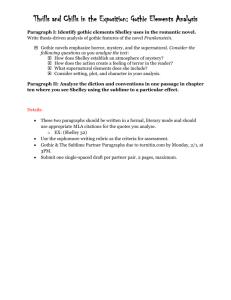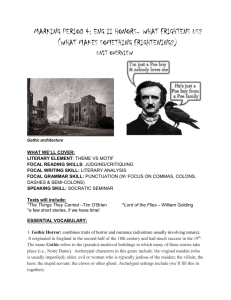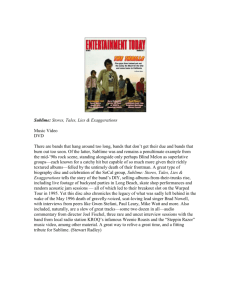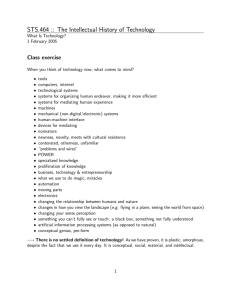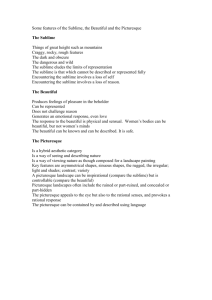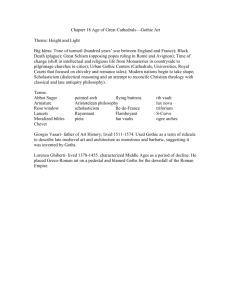Anticipation of the Romantic poetry The Augustan aesthetic theory of
advertisement
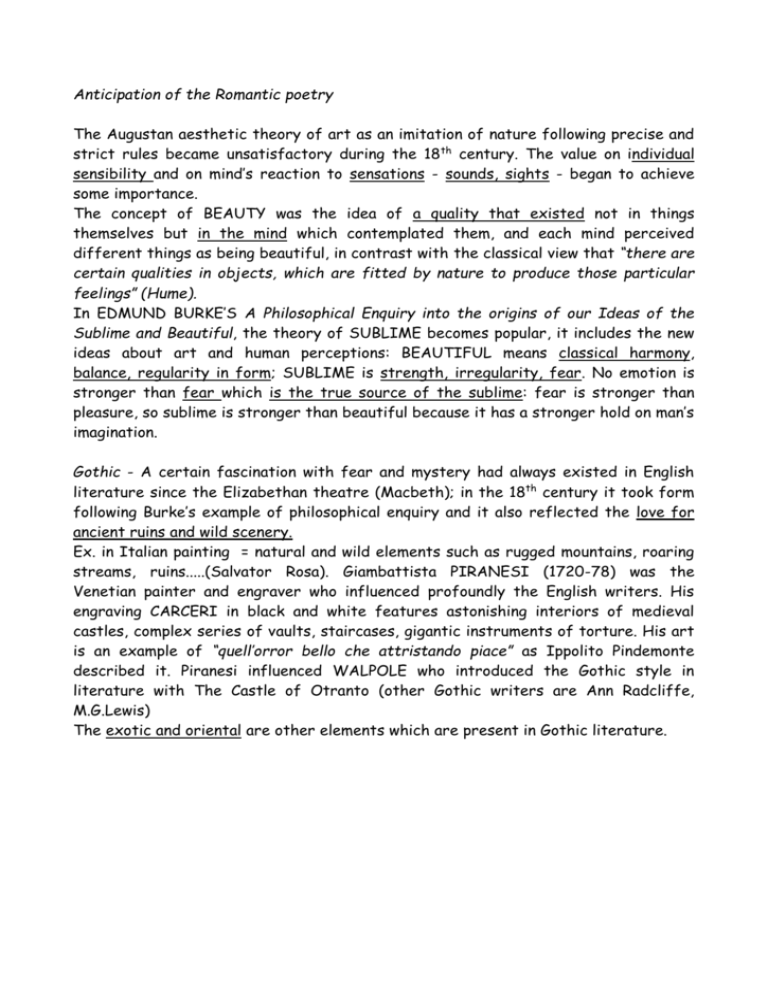
Anticipation of the Romantic poetry The Augustan aesthetic theory of art as an imitation of nature following precise and strict rules became unsatisfactory during the 18th century. The value on individual sensibility and on mind’s reaction to sensations - sounds, sights - began to achieve some importance. The concept of BEAUTY was the idea of a quality that existed not in things themselves but in the mind which contemplated them, and each mind perceived different things as being beautiful, in contrast with the classical view that “there are certain qualities in objects, which are fitted by nature to produce those particular feelings” (Hume). In EDMUND BURKE’S A Philosophical Enquiry into the origins of our Ideas of the Sublime and Beautiful, the theory of SUBLIME becomes popular, it includes the new ideas about art and human perceptions: BEAUTIFUL means classical harmony, balance, regularity in form; SUBLIME is strength, irregularity, fear. No emotion is stronger than fear which is the true source of the sublime: fear is stronger than pleasure, so sublime is stronger than beautiful because it has a stronger hold on man’s imagination. Gothic - A certain fascination with fear and mystery had always existed in English literature since the Elizabethan theatre (Macbeth); in the 18th century it took form following Burke’s example of philosophical enquiry and it also reflected the love for ancient ruins and wild scenery. Ex. in Italian painting = natural and wild elements such as rugged mountains, roaring streams, ruins.....(Salvator Rosa). Giambattista PIRANESI (1720-78) was the Venetian painter and engraver who influenced profoundly the English writers. His engraving CARCERI in black and white features astonishing interiors of medieval castles, complex series of vaults, staircases, gigantic instruments of torture. His art is an example of “quell’orror bello che attristando piace” as Ippolito Pindemonte described it. Piranesi influenced WALPOLE who introduced the Gothic style in literature with The Castle of Otranto (other Gothic writers are Ann Radcliffe, M.G.Lewis) The exotic and oriental are other elements which are present in Gothic literature. The Poetry of Transition In the second half of the 18th century there is a gradual change from the Augustan sensibility towards nature to a new concept, a new interest in it. Nature acquires a new, modern connotation, nature as rivers, mountains,skyscapes, as opposed to the neoclassical meaning of order, supreme organiser of the physical and spiritual world. Poets start to describe natural scenes in simple language, often with a pervading sadness. The cult of sentiment is another new feature, searching for emotions and feelings became fashionable (Goldsmith). There is also a revival for the Gothic art and literature of the Middle Ages, seen as exotic (revival of Gaelic poems, celebrating the deeds of OSSIAN, a legendary warrior - Ossian poems by J. Macpherson). Melancholy, the desolate and the picturesque - there was a general interest in these feelings; the desolate (graveyards, ruins), the picturesque go beyond reason, appealing to popular taste and imagination. They become an obsession, described with macabre scenes, tombs, stormy landscapes by the Graveyard School, a group of poets with THOMAS GRAY as one of the major figures. The Romantics were attracted by his visions in natural scenes, by the observation of the creativity of the ordinary mind (folk tradition). T. GRAY- Elegy written in a Country Churchyard - a pre-Romantic trait was predilection for melancholy, inspiration drew from night scenes and graveyards. UGO FOSCOLO’S Carme dei Sepolcri was inspired by Gray’s work. The common theme is that graves represent inspiration for the living; Gray sings the glory of common people, Foscolo is moved by the tombs of great men, they both see all human activities obliterated by death.
